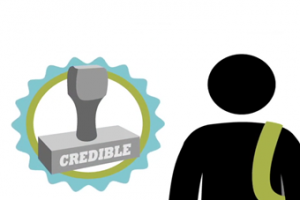4.6 Evaluate sources
Information sources vary in quality, and before you use a source in your academic assignments or work projects, you must evaluate them for quality. You want your own work to be of high quality, credible, and accurate, and you can only achieve that by having sources possess those same qualities.
Watch this video on evaluating sources for an overview of what credibility is, why it’s important, and some of the criteria to look for when evaluating a source.

There are five basic criteria for evaluating information. While it may seem like a lot to think about at first, after a little practice, you will find that you can evaluate sources quickly.
Here are the five basic criteria, with key questions and indicators to help you evaluate your source:
- Authority
- Key Question: Is the person, organization, or institution responsible for the intellectual content of the information knowledgeable in that subject?
- Indicators of authority: formal academic degrees, years of professional experience, active and substantial involvement in a particular area
- Accuracy
- Key Question: How free from error is this piece of information?
- Indicators of accuracy: correct and verifiable citations, information is verifiable in other sources from different authors/organizations, author is authority on subject
- Objectivity
- Key Question: How objective is this piece of information?
- Indicators of objectivity: multiple points of view are acknowledged and discussed logically and clearly, statements are supported with documentation from a variety of reliable sources, purpose is clearly stated
- Currency
- Key Question: When was the item of information published or produced?
- Indicators of currency: publication date, assignment restrictions (e.g., you can only use articles from the last 5 years), your topic and how quickly information changes in your field (e.g., technology or health topics will require very recent information to reflect rapidly changing areas of expertise)
- Audience
- Key Question: Who is this information written for or this product developed for?
- Indicators of audience: language, style, tone, bibliographies
When evaluating and selecting sources for an assignment or work project, compare your sources to one another in light of your topic. Imagine, for example, you are writing a paper about bicycle commuting. You have three sources about bicycle safety. One is written for children; one is for adult recreational bicyclers; and one is for traffic engineers. Your topic is specifically about building urban and suburban infrastructure to encourage bicycling, so the source written for traffic engineers is clearly more appropriate for your topic than the other two. Even if the other two are high-quality sources, they are not the most relevant sources for your specific topic.
Until you have practiced evaluating many sources, it can be a little difficult to find the indicators, especially in web sources.
Table 6. Locations where you might find indicators of quality in different types of sources
| If you are looking for indications of… | In books see the… | In journals see the… | In websites see the… |
| Authority | Title page, Forward, Preface, Afterward, Dust Jackets, Bibliography | Periodical covers, Editorial Staff, Letters to the Editor, Abstract, Bibliography | URL, About Us, Publications, Appearance |
| Accuracy | Title page, Forward, Preface, Afterward, Periodical covers, Dust Jackets, Text, Bibliography | Periodical covers, Text, Bibliography | URL, About Us, Home page, Awards, Text |
| Objectivity | Forward, Preface, Afterward, Text, Bibliorgraphy | Abstracts, Text, Bibliography, Editorials, Letters to the Editor | About Us, Site Map, Text, Disclaimers, Membership/Registration |
| Currency | Title page, copyright page, Bibliography | Title page, Bibliorgraphy, Abstracts | Home page, Copyright, What’s New |
| Audience | Forward, Preface, Afterward | Letters to the editor, Editorial, Appearance | Home page, About, Mission, Disclaimer, Members only |
When you have located and evaluated information for your paper, report, or project, you will use it to complete your work. A later chapter of this text will cover how to use it correctly and ethically.
Chapter Attribution Information
Evaluate Sources derived by Annemarie Hamlin, Chris Rubio, and Michele DeSilva, Central Oregon Community College, from Evaluating Information by Virginia Tech Libraries, CC: BY-NC-SA 4.0

